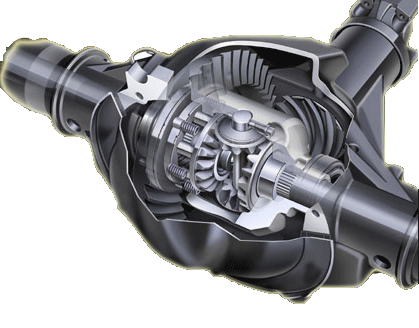
Background and History
HYDR-MATIC / PARKING PAWL
CIRCA 1939
CIRCA 1939
First automatic transmission automobiles and the auto industry's efforts ever since to prevent unintended vehicle movement through the use of a "Parking Pawl"
The first automobile automatic transmission the "Hydra-Matic" was introduced in 1939. It was manufactured by General Motors and installed in certain model year 1940 Oldsmobiles.
However, unlike with a manual transmission, where when a car is turned off in gear the engine compression acts to prevent vehicle movement on slight slopes, with an automatic transmission, when the vehicle is turned off, the engine is disconnected from the wheels and the vehicle can roll.
As a result, the first "hydra-matic" included what was called a "parking pawl". When engaged, the parking pawl mechanically locks the transmission, preventing movement of the wheels. Initially, on "hydra-matic" transmission, the park pawl was engaged in the reverse position when the transmission was turned off.


Hydramatic - first automobile automatic transmission introduced in 1939
Parking pawl was introduced to lock the transmission, preventing wheel movement

CIRCA 1956
INTRODUCTION OF "PARK" POSITION
In 1956, GM introduced an updated automatic transmission, which had a "park" position, placing the vehicle in "park" engaged the park pawl and prevented vehicle movement, without having to manually engage park as with prior transmissions. Over time this innovation became standard for automatic transmissions.
However for all of their advantages, automatic transmissions have one major safety issue compared to traditional manual transmissions.
In a manual transmission, if a driver makes a shifting error and attempted to exit in gear, the engine will immediately kill once the clutch is released. In the rare event of leaving a manual transmission vehicle running in neutral, drivers know to set the "parking brake". As such, powered vehicle roll-away on manual transmissions is almost unknown.
On automatic transmission equipped vehicles, however, the vehicle can be left running in gear and remain stationary, appearing to be in park if obstructed by an object or a terrain feature, when the vehicle is actually in a powered gear. The vehicle can also be turned off in gear and if not shifted to park, it will roll. Both are problems that did not exist on manual transmissions. Equally dangerous, unless they are properly designed, automatic transmissions can be left between gears, where they appear to be in park, but are actually in between gears and can reengage a powered gear after a delay.
CIRCA 1956
Introduction of the "Park" position. Placing the transmission in "Park" engaged the park pawl and prevented vehicle movement.
Safety issues can arise when a driver makes a shifting error and the vehicle appears to be in "Park" but is actually in a powered gear or in "False Park"


Introduction of the "Park" position in the transmission
PREVENTING ROLL-AWAY INJURIES
The auto industry has developed several fail-safe systems which were installed on vehicles either to reduce or prevent inadvertent movement issues
To try to address these issues, manufactures of automatic transmission equipped vehicles have adopted several safety systems.
-
First, is the installation of an effective "detent system" that should (if properly designed using a strong enough effective spring force) place the vehicle into an intended gear position if the shift selector is inadvertently left between gears.
-
Second, is the use of a Key Ignition Transmission Shift Interlock (KITSI) which prevents the key being removed unless the vehicle is in park, which helps to prevent unpowered vehicle roll-away.
-
Third, is the use of a system to guard or warn against inadvertently exiting a vehicle when not in park. This has been done by using driver's door locks that can not be opened when the vehicle is not in park, absent an express override. Alternatively, certain manufacturers have installed an "out-of-park warning alarm" or "not in park alarm" which sounds when the driver's door is opened, the driver's seat belt is unbuckled, the vehicle is not in park, and the driver's foot is not on the brake.
However, despite these vehicle safety systems being on many vehicles, there continues to be a large number of serious injuries and deaths which result from "inadvertent movement" on vehicles where these systems are either absent or not appropriately designed.


To address misshifts to between grears, the "detent system" is used to center the transmission into an intended gear
The second method is to put a "Key Shift Interlock" in, which prevents the key from being removed unless the vehicle is in park